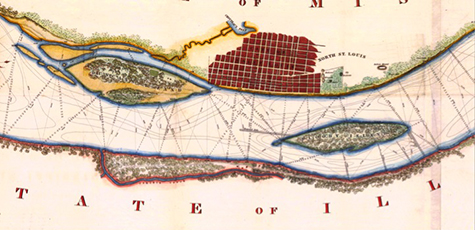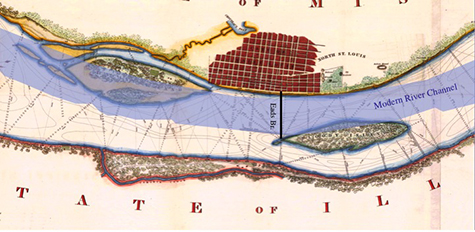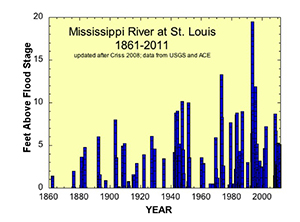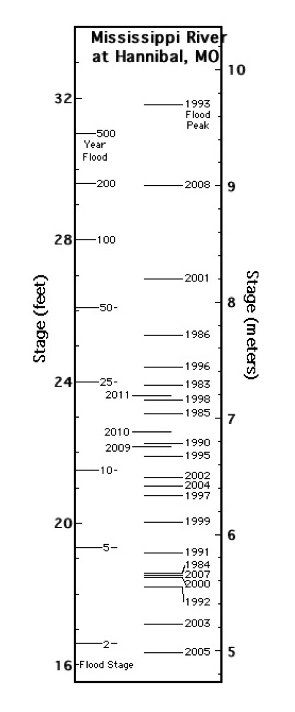

The Jan. 17 issue of The New York Times celebrated “the remarkable feat of engineering” that kept the Mississippi River open to barge traffic despite extreme drought in the Midwest. The U.S. Army Corps of Engineers, the article said, had dredged, blasted and scraped away rock obstructions along the riverbed, lowering the bottom of the channel at Thebes, Ill., by 2 feet.
What’s more, engineers and water managers had awoken every two hours through the night to release precise amounts of water from upstream reservoirs so as not to waste a single drop. It had been, in short, a heroic effort to rise to the challenge of falling water levels.
A hydrogeologist at Washington University in St. Louis, who has watched and brooded over the nearby river for 18 years, sees it quite differently. “It was a trumped-up crisis,” says Robert E. Criss, PhD, a professor of earth and planetary sciences at WUSTL, “and I am offended by the way the news media has puffed it.

“We’ve got to start to recognize the realities of how rivers work,” Criss says.
The shipping industry wants to maintain a 9-foot depth so that barges carrying fossil fuels, grain and gravel can move down the river all year long.
But, says Criss, rivers are low in this part of the world at this time of year. In the normal annual cycle, the water recedes in the dry months of the fall, tapers off in the winter and then in the spring, the river floods.
He also points out that the Missouri River, which empties into the Mississippi north of St. Louis and accounts for 45 percent of the annual flow of the river as it passes St. Louis, has a huge catchment (it rises in western Montana) but one that receives very little rainfall. Most of the watershed gets less than 20 inches of precipitation a year, about as much as Iraq.
“We’ve got to stop subsidizing anachronistic industries like the barge industry,” he says. “The barge companies would be out of business in a hot minute,” Criss says, “if they had to maintain their own river channel and pay to use locks.”
Several recent news stories have quoted shippers saying they cannot afford the cost of shipping by rail rather than by barge. “They’re right,” says Criss, “but only because the economics have been skewed by public policy: Railroads pay to maintain their own track.
“We can pretend barges can move tonnage cheaper, but the system they use is subsidized by the taxpayer and costs us dearly,” Criss says.
“I believe that good environmentalism is good economics,” Criss says, “and we’ll make good choices only if we factor into the accounting the cost of the use or degradation of a natural resource we hold in common, such as the air or water.”
The barge industry was rescued this time by blasting, but also by the release of 150,000 acre-feet of water from Lake Carlyle, a reservoir on the Kaskaskia River in Illinois. This “free” water, Criss says, would be worth many millions of dollars in the drought-stricken western United States.
“We’re living in an imaginary world,” says Criss, “and not dealing with our problems realistically. We should be investing in things where there is an opportunity for growth in the future, and there is no possibility of long-term growth in sending bulk-tonnage materials halfway around the world.”
Criss doubts not only the accounting, but even the facts in stories about the river. On Jan. 8 the St. Louis Post-Dispatch said the river levels were the lowest they had been in seven decades.

Not so, said Criss, in a follow-up letter to the editor. The river was as low or lower in 1989 and in 2003. He points out that detailed stage records are provided online by the U.S. Geological Survey and by the National Weather Service’s “Rivers and Lakes” pages.
Criss, having battled the U.S. Army Corps of Engineers for years, no longer trusts their calculations (see adjacent diagram). He is not alone in this. In 2000, a Senate subcommittee accused the corps of “skewing data to justify higher spending for water projects,” according to The New York Times.
In 2005, again according to The New York Times, the National Academy of Sciences found that “the agency routinely inflated the economic payoffs of its construction projects to justify steadily greater budget outlays, while underestimating the environmental damage of those projects.”
In 2006, Sens. John McCain, R-Ariz., and Russ Feingold, D-Wisc., introduced amendments to a Water Resources Development that required proposed corps projects be submitted to peer review. The act became law in 2007, but by then Feingold had withdrawn his support because he felt the reform would not change the way the corps did business.
Criss points out that crises on the Mississippi will only become more frequent because climate change is expected to amplify stream flow variations. “Just last year, the river was too high for barges,” he says, “yet this year the river is too low for barges.”
For more about Criss, see http://eps.wustl.edu/people/bob_criss.